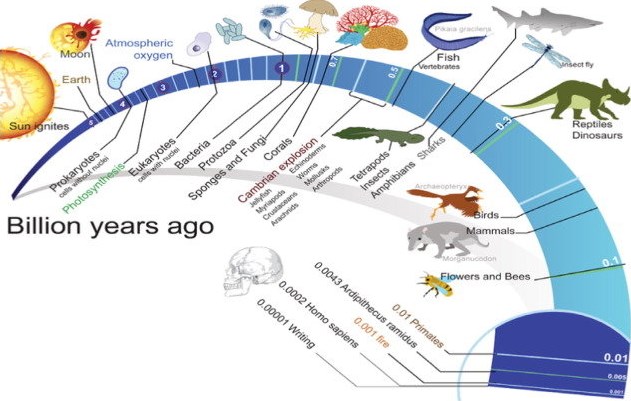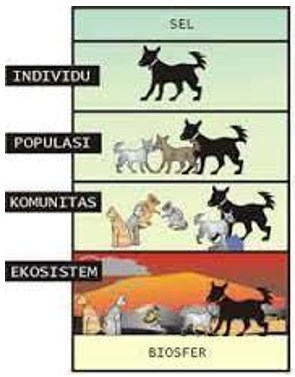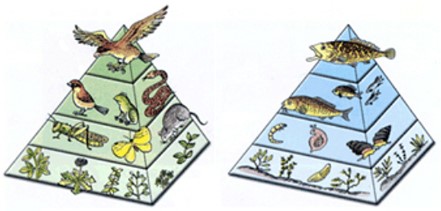A. The Role of Biology as Science
Is biology a science? A thing can become a science if it has several conditions, including: systematically structured, empirical (can be proven), has a method, has an object of research, and can be reasonably accepted. For biology epistemologically, it comes from the Greek word bios means “life” and logos means “science”. So, biology is the science of life literally. However, biology is not just about studying the process of life and what makes a living thing alive. Biology also learn about the habitat of living things to the relationship between living things with one another.
Besides, biology is also a science that studies or learn about living things with all their problems. Biology as science has the same characteristics as any other science. Technology determines the development of biological sciences. As a science, biology is born and develops through observations and experiments have several steps in scientific work.
Biology is part of science that has the same characteristics as other sciences. The aspects of natural sciences including biology are:
- The study object is a concrete object and can research.
- Developed are based on empirical research (real experience).
- Have systematic measures that are standard.
- Apply a logical way of thinking, which is deductive means thinking by concluding things that are specific to the general provisions. It is productive to think by common things into specific provisions. The result is objective, avoided by the interests of the perpetrator (subjective). The results in the form of common laws, wherever applicable.
Organizational Structure of Life
Organisms that are composed of one cell are called unicellular, and if there are organisms are composed of a lot of cells called multicellular. In unicellular organisms, all living functions are carried out by the cells themselves. Because the function of life is not only one, then there is a system consisting of subsystems, more subsystems that make the organism more complex..
a. Molecular Level Organization
The body of a living organism is composed of organic molecules, namely molecules containing carbon (C), hydrogen (H), and oxygen (O) atoms. There are 4 kinds of organic molecules or groups, namely:
- Lipid molecules. This molecule contains a large of carbon, hydrogen, and oxygen, and sometimes contains nitrogen and phosphorus. In the cells, there are various types of lipids, including fat, phospholipids, and steroids.
- Carbohydrate molecules. This molecule contains carbon, hydrogen, and oxygen atoms. An example of a carbohydrate is glucose. This glucose is the most important source of energy or fuel for living organisms.
- Protein molecules. This molecule is a macro-molecule shape like a polymer (formed by amino acids as its monomers) and is not branched. Composed of the elements carbon (C), hydrogen (H) oxygens (O), and nitrogen (N), and sometimes accompanied by elements of sulfur (S), and phosphorus (P). Protein is approximately 50% of the dry weight of a living organism. Proteins in this living organism have reactions as enzymes, a source of energy useful for muscle movement, some responsible for the transport of nutrition through circulatory such as hemoglobin and anti-body substances, some that useful as food supplies e.g. ovalbumin in egg whites and casein in milk. Protein is also an ingredient for repair, growth, and maintenance of the cell structure of the body’s organs. There are 20 kinds of amino acids that make up various kinds of proteins in the body of living organisms.
- Nucleic acid molecules. These molecules are the only molecules that carry the genetic information of living organisms. There are two large groups of nucleic acids namely are Deoxyribonucleic acid (DNA) and Ribonucleic acid (RNA).
b. Cell Level Organization
In living organisms, the atoms bond to form molecules. These molecules adjusted into a complex system of interactions then formed into a cell. In other words, these organic molecules combine to form cell organelles. These various organelles interact with each other to form the smallest unit of living things/organisms called cells.
c. Tissue-Level Living Organization
This level of living organization is not owned by unicellular organisms but is owned only by multicellular organisms. Because all living activity in unicellular organisms is carried out by the cells themselves. While in multicellular organisms living activities are carried out by many cells that arranged or organized and well connected until it becomes a unit of function forming one individual body.
The organization of life after the molecular and cellular level is the tissue level. What is tissue? A tissue is a collection of cells that look the same to carry out a specific function. In the world of higher animals and humans, there are five kinds of basics tissues that make up their bodies. The five tissue are epithelium, muscle, connective, bone, and nerve. While in the plant varieties there are seven kinds of basics tissues that make up the body. The seven basics tissues are tissue: epidermis, parenchyma, collenchyma, sclerenchyma, endodermis, xylem, and phloem. Examples of tissue in animals and humans are neural tissue. This neural tissue is composed of nerve cells (neurons), which carry out impulses. And an example of tissue in higher plants is the xylem tissue composed of xylem cells, which carry water and mineral salts from the soil to the leaves.
d. Organ-Level Living Organization
Organs are a collection of several tissues capable of carrying out one particular function. Organs in animals and humans include the intestines, heart, lungs, liver, stomach, eyes, and so on.
Organs in plants consist of:
- Root: an organ that serves as a tool to support the establishment of the plant body in its place of life, absorb nutrients, and store food reserves.
- Stem: an organ that functions to connect the roots and leaves to straighten the tree trunk, and store food reserves.
- Leaf: an organ that is responsible for photosynthesis, water evaporation, and air exchange.
e. Organ System Level Living Organization
Organ systems are organs that work together to perform certain functions in the body of an organism. Examples of organ systems, such as organ systems in humans, include the excretory system, respiratory system, digestive system, and nervous system. Each organ system cooperates. If the function of one system is disturbed, the other system will be disturbed. The cooperation of organ systems will form an organism.
f. Organization of Individual, Population and Community Level Living
These organ systems interact with each other, support each other, or influence each other and form a single body known as the individual. If the human body there is a distraction in one of the organ systems, the other’s organ systems are also affected. Therefore, maintaining a balanced function of an organ system means maintaining work harmony between the organ systems, and can keep the body healthy. So the individual is an organism whose body is composed of various interconnected organ systems. In a broader environment, the individual is defined as a single living entity, for example, a bird, a cow, a coconut tree, a rice plant, a child, a mother, and so on.
The word individual comes from Latin, namely Individuum which means ‘indivisible’. Individuals live in a place (habitat). In their habitat, individuals are certainly not alone. He will live together with other individuals, both of the same kind and a different kind. Individuals are said to be of one type or one species if they can marry and produce fertile offspring, for example, hens and roosters are of one species. The population is a group or group of individuals who are of the same type and live in a place or area with a certain time, which is like a fish population, that is, they live in a pond where fish are similar.
A community is a collection of various populations living in a particular area or place that interact with one another. Communities are more complex when compared to individuals and populations. All organizations are part of the community and its components along with interconnected with a variety of interactions. An example of a community is a population of algae, fish, and surrounding animals that form a coral reef community.
|
Term |
Description |
|
Environment |
All the conditions that surround a living organism |
|
Habitat |
The place where an organism lives |
|
Population |
All the members of a single species that live in a habitat |
|
Community |
All the populations of different organisms that live together in a habitat |
|
Ecosystem |
A community and the habitat in which organisms live |
g. Ecosystem, Biome, and Biosphere Level Life Organization
Ecosystems are organizational levels of life that include organisms and non-living environments, where the two components influence and interact with each other. In the ecosystem, every organism has a role, some act as producers, consumers, decomposers, or detritivores. Manufacturers consist of chlorophyll (autotrophy) organisms capable of producing organic substances from inorganic substances (through photosynthesis). These organic substances are then utilized by heterotrophs organisms (humans and animals) that act as consumers. As consumers, animals eat manufacturers directly, but some get food indirectly from manufacturers by eating other consumers.
The role of the ecosystem will shape the food chain and even food webs. Look at the example of this food chain : green leaves (Producer) → caterpillar (Consumer I) →chicken (Consumer II) → weasel (Consumer III) → tiger (Consumer IV/Top of Food Chain).
The Food Chain Explanation: The answer has to do with trophic levels. As you probably know, the organisms at the base of the food chain are photosynthetic; plants on land and phytoplankton (algae) in the oceans. These organisms are called the producers, and they get their energy directly from sunlight and inorganic nutrients. The organisms that eat the producers are the primary consumers. They tend to be small in size and there are many of them. The primary consumers are herbivores (vegetarians). The organisms that eat the primary consumers are meat eaters (carnivores) and are called the secondary consumers. The secondary consumers tend to be larger and fewer in number. This continues on, all the way up to the top of the food chain. About 50% of the energy (possibly as much as 90%) in food is lost at each trophic level when an organism is eaten, so it is less efficient to be a higher order consumer than a primary consumer. Therefore, the energy transfer from one trophic level to the next, up the food chain, is like a pyramid; wider at the base and narrower at the top. Because of this inefficiency, there is only enough food for a few top level consumers, but there is lots of food for herbivores lower down on the food chain. There are fewer consumers than producers.
|
Trophic Level |
Desert Biome |
Grassland Biome |
Pond Biome |
Ocean Biome |
|
Producer (Photosynthetic) |
Cactus |
Grass |
Algae |
Phytoplankton |
|
Primary Consumer (Herbivore) |
Butterfly |
Grasshopper |
Insect Larva |
Zooplankton |
|
Secondary Consumer (Carnivore) |
Lizard |
Mouse |
Minnow |
Fish |
|
Tertiary Consumer (Carnivore) |
Snake |
Snake |
Frog |
Seal |
|
Quaternary Consumer (Carnivore) |
Roadrunner |
Hawk |
Raccoon |
Shark |
Food Web: At each trophic level, there may be many more species than indicated in the table above. Food webs can be very complex. Food availability may vary seasonally or by time of day. An organism like a mouse might play two roles, eating insects on occasion (making it a secondary consumer), but also dining directly on plants (making it a primary consumer). A food web of who eats who in the southwest American desert biome might look something like this:
- Keystone Species: In some food webs, there is one critical “keystone species” upon which the entire system depends. In the same way that an arch collapses when the keystone is removed, an entire food chain can collapse if there is a decline in a keystone species. Often, the keystone species is a predator that keeps the herbivores in check, and prevents them from overconsuming the plants, leading to a massive die off. When we remove top predators like grizzly bears, orca whales, or wolves, for example, there is evidence that it affects not just the prey species, but even the physical environment.
- Apex Predators: These species are at the top of the food chain and the healthy adults have no natural predators. The young and old may in some cases be preyed upon, but they typically succumb to disease, hunger, the effects of aging, or some combination of them. The also suffer from competition with humans, who often eliminate the top predators in order to have exclusive access to the prey species, or through habitat destruction, which is an indirect form of competition.
- Decomposers: When organisms die, they are sometimes eaten by scavengers but the remaining tissues are broken down by fungi and bacteria. In this way, the nutrients that were part of the body are returned to the bottom of the trophic pyramid.
- Bioaccumulation: In addition to being less energy efficient, eating higher up the food chain has its risks. Pesticides and heavy metals like mercury, arsenic, and lead tend to be consumed in small quantities by the primary consumers. These toxins get stored in the fats of the animal. When this animal is eaten by a secondary consumer, these toxins become more concentrated because secondary consumers eat lots of primary consumers, and often live longer too. Swordfish and tuna are near the top of the aquatic food chain and, when we eat them, we are consuming all of the toxins that they have accumulated over a lifetime. For this reason, pregnant women are advised against eating these foods.
The role of the decomposer is occupied by saprophytic organisms, namely decomposing bacteria, and saprobic fungi. The existence of decomposers is very important in the ecosystem. By decomposers, dead animals or plants will be broken down and returned to the soil into nutrients (inorganic substances) which are essential for plant growth. The decomposing activity also produces carbon dioxide gas which is important for photosynthesis. Detritivores are organisms that eat detritus (the destruction of dead organisms). In essence, in the organization of life at the ecosystem level, there are processes of circulation of matter, transformation, accumulation of energy, and accumulation of matter through organisms. The ecosystem is also an open and dynamic system. The entry and exit of energy and matter aim to maintain the organization and maintain its function.
The biome is a collection of species (especially plants) inhabiting a certain place on earth which is characterized by certain dominant vegetation and is immediately apparent in that place. Therefore, biomes are usually named based on the dominant plants in the area. On the surface of the earth, there are 7 types of biomes, namely: tundra, taiga (targe), desert (desert), grasslands, savanna, tropical rain forest, and deciduous forest.












